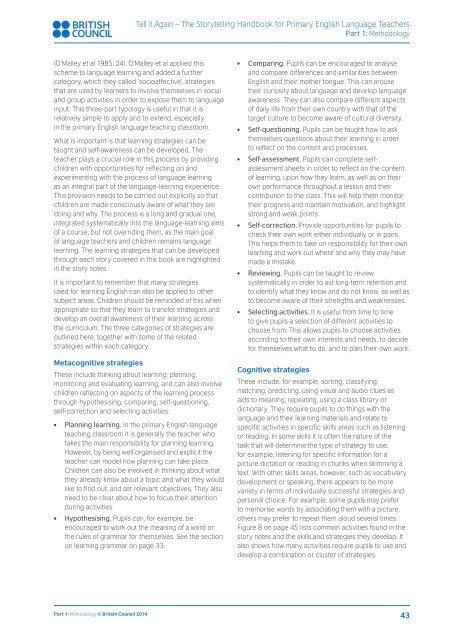1nW0gvB
1nW0gvB
1nW0gvB
Create successful ePaper yourself
Turn your PDF publications into a flip-book with our unique Google optimized e-Paper software.
Tell it Again – The Storytelling Handbook for Primary English Language Teachers<br />
Part 1: Methodology<br />
(O’Malley et al 1985: 24). O’Malley et al applied this<br />
scheme to language learning and added a further<br />
category, which they called ‘socioaffective’, strategies<br />
that are used by learners to involve themselves in social<br />
and group activities in order to expose them to language<br />
input. This three-part typology is useful in that it is<br />
relatively simple to apply and to extend, especially<br />
in the primary English language teaching classroom.<br />
What is important is that learning strategies can be<br />
taught and self-awareness can be developed. The<br />
teacher plays a crucial role in this process by providing<br />
children with opportunities for reflecting on and<br />
experimenting with the process of language learning<br />
as an integral part of the language-learning experience.<br />
This provision needs to be carried out explicitly so that<br />
children are made consciously aware of what they are<br />
doing and why. The process is a long and gradual one,<br />
integrated systematically into the language-learning aims<br />
of a course, but not overriding them, as the main goal<br />
of language teachers and children remains language<br />
learning. The learning strategies that can be developed<br />
through each story covered in this book are highlighted<br />
in the story notes.<br />
It is important to remember that many strategies<br />
used for learning English can also be applied to other<br />
subject areas. Children should be reminded of this when<br />
appropriate so that they learn to transfer strategies and<br />
develop an overall awareness of their learning across<br />
the curriculum. The three categories of strategies are<br />
outlined here, together with some of the related<br />
strategies within each category.<br />
●●<br />
●●<br />
●●<br />
●●<br />
●●<br />
●●<br />
Comparing. Pupils can be encouraged to analyse<br />
and compare differences and similarities between<br />
English and their mother tongue. This can arouse<br />
their curiosity about language and develop language<br />
awareness. They can also compare different aspects<br />
of daily life from their own country with that of the<br />
target culture to become aware of cultural diversity.<br />
Self-questioning. Pupils can be taught how to ask<br />
themselves questions about their learning in order<br />
to reflect on the content and processes.<br />
Self-assessment. Pupils can complete selfassessment<br />
sheets in order to reflect on the content<br />
of learning, upon how they learn, as well as on their<br />
own performance throughout a lesson and their<br />
contribution to the class. This will help them monitor<br />
their progress and maintain motivation, and highlight<br />
strong and weak points.<br />
Self-correction. Provide opportunities for pupils to<br />
check their own work either individually or in pairs.<br />
This helps them to take on responsibility for their own<br />
learning and work out where and why they may have<br />
made a mistake.<br />
Reviewing. Pupils can be taught to review<br />
systematically in order to aid long-term retention and<br />
to identify what they know and do not know, as well as<br />
to become aware of their strengths and weaknesses.<br />
Selecting activities. It is useful from time to time<br />
to give pupils a selection of different activities to<br />
choose from. This allows pupils to choose activities<br />
according to their own interests and needs, to decide<br />
for themselves what to do, and to plan their own work.<br />
Metacognitive strategies<br />
These include thinking about learning: planning,<br />
monitoring and evaluating learning, and can also involve<br />
children reflecting on aspects of the learning process<br />
through hypothesising, comparing, self-questioning,<br />
self-correction and selecting activities.<br />
●●<br />
●●<br />
Planning learning. In the primary English language<br />
teaching classroom it is generally the teacher who<br />
takes the main responsibility for planning learning.<br />
However, by being well organised and explicit the<br />
teacher can model how planning can take place.<br />
Children can also be involved in thinking about what<br />
they already know about a topic and what they would<br />
like to find out, and set relevant objectives. They also<br />
need to be clear about how to focus their attention<br />
during activities.<br />
Hypothesising. Pupils can, for example, be<br />
encouraged to work out the meaning of a word or<br />
the rules of grammar for themselves. See the section<br />
on learning grammar on page 33.<br />
Cognitive strategies<br />
These include, for example, sorting, classifying,<br />
matching, predicting, using visual and audio clues as<br />
aids to meaning, repeating, using a class library or<br />
dictionary. They require pupils to do things with the<br />
language and their learning materials and relate to<br />
specific activities in specific skills areas such as listening<br />
or reading. In some skills it is often the nature of the<br />
task that will determine the type of strategy to use,<br />
for example, listening for specific information for a<br />
picture dictation or reading in chunks when skimming a<br />
text. With other skills areas, however, such as vocabulary<br />
development or speaking, there appears to be more<br />
variety in terms of individually successful strategies and<br />
personal choice. For example, some pupils may prefer<br />
to memorise words by associating them with a picture,<br />
others may prefer to repeat them aloud several times.<br />
Figure 8 on page 45 lists common activities found in the<br />
story notes and the skills and strategies they develop. It<br />
also shows how many activities require pupils to use and<br />
develop a combination or cluster of strategies.<br />
Part 1: Methodology © British Council 2014<br />
43


